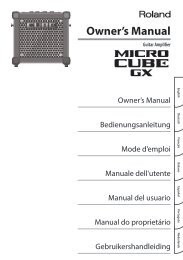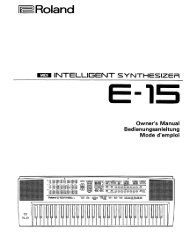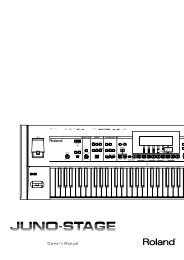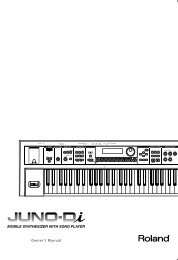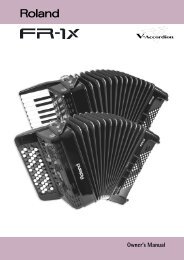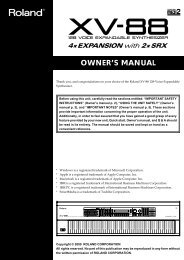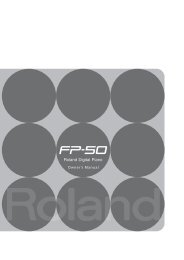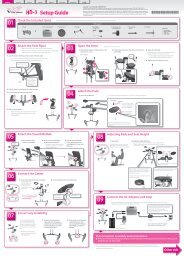Owner's Manual - Roland
Owner's Manual - Roland
Owner's Manual - Roland
You also want an ePaper? Increase the reach of your titles
YUMPU automatically turns print PDFs into web optimized ePapers that Google loves.
Overview of the Fantom VS<br />
Note Priority in Performance<br />
94<br />
Since Performance is usually used to play an ensemble<br />
consisting of several patches, it is important to decide which<br />
parts take priority. Priority is specified by the Voice Reserve<br />
settings (p. 140). When a note within a patch needs to be<br />
turned off to make room for a new note, the Patch Priority<br />
setting of the patch will apply (p. 97).<br />
Voice Reserve<br />
The Fantom VS has a Voice Reserve function that lets you<br />
reserve a minimum number of notes that will always be<br />
available for each part. For example if Voice Reserve is set to<br />
“10” for part 16, part 16 will always have 10 notes of soundproducing<br />
capacity available to it even if a total of more than<br />
128 notes (total for all parts) are being requested. When you<br />
make Voice Reserve settings, you need to take into account<br />
the number of notes you want to play on each part as well as<br />
the number of tones used by the selected patch (p. 140).<br />
It is not possible to make Voice Reserve settings that<br />
would cause the total of all parts to be greater than 128<br />
voices.<br />
About Memory<br />
Patch and performance settings are stored in what is referred<br />
to as memory. There are two kind of memory: temporary and<br />
non-rewritable.<br />
fig.04-006.e<br />
Fantom VS<br />
Temporary Memory<br />
Temporary Area<br />
This is the area that holds the data for the patch that you’ve<br />
selected.<br />
When you play the Fantom VS, sound is produced based on<br />
data in the temporary area. When you edit a patch, you do<br />
not directly modify the data in memory; rather, you call up<br />
the data into the temporary area, and edit it there.<br />
Settings in the temporary area are temporary, and will be lost<br />
when the power is turned off or when you select another<br />
patch/performance.<br />
Non-Rewritable Memory<br />
Preset Memory<br />
Preset I (PR-I)<br />
Preset H (PR-H)<br />
Preset G (PR-G)<br />
Preset F (PR-F)<br />
Preset E (PR-E)<br />
Preset D (PR-D)<br />
Preset C (PR-C)<br />
Preset B (PR-B)<br />
Preset A (PR-A)<br />
Patch<br />
128<br />
Rhythm Set<br />
19 * 1<br />
Select Select<br />
Temporary Area<br />
GM (GM2)<br />
Patch<br />
256<br />
Rhythm Set<br />
9<br />
System<br />
* 1 Only in PR-A (PRST)<br />
* 2 The selected Patches/Rhythm Sets cannot be changed.<br />
Data in Preset memory cannot be rewritten. However, you<br />
can call up settings from preset memory into the temporary<br />
area, and modify them.<br />
* 2



